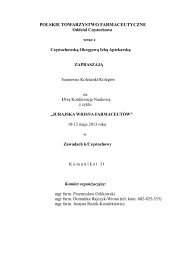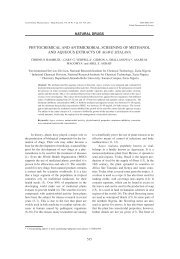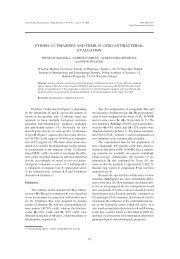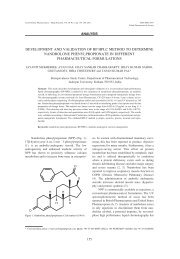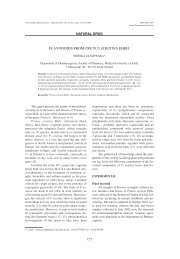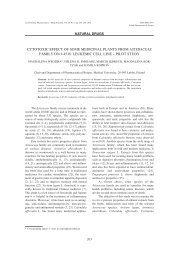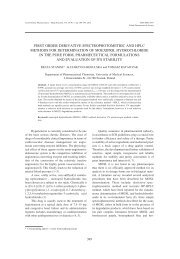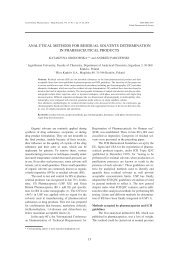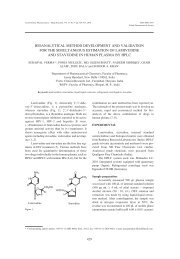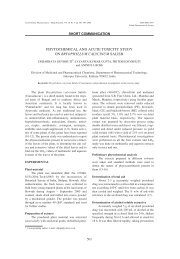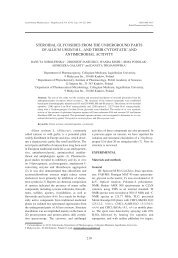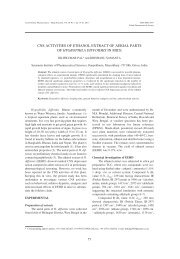hypotensive effect of aqueous extract of the leaves of phyllanthus ...
hypotensive effect of aqueous extract of the leaves of phyllanthus ...
hypotensive effect of aqueous extract of the leaves of phyllanthus ...
You also want an ePaper? Increase the reach of your titles
YUMPU automatically turns print PDFs into web optimized ePapers that Google loves.
Acta Poloniae Pharmaceutica ñ Drug Research, Vol. 64 No. 6 pp. 547ñ552, 2007 ISSN 0001-6837<br />
Polish Pharmaceutical Society<br />
HYPOTENSIVE EFFECT OF AQUEOUS EXTRACT OF THE LEAVES OF<br />
PHYLLANTHUS AMARUS SCHUM AND THONN (EUPHORBIACEAE).<br />
*FABIAN C. AMAECHINA and ERIC K. OMOGBAI<br />
Department <strong>of</strong> Pharmacology and Toxicology, University <strong>of</strong> Benin, Benin City, Nigeria<br />
Abstract: The plant <strong>of</strong> Phyllanthus amarus is used as diuretic and to lower blood pressure in traditional medicine<br />
practice. The <strong>effect</strong> <strong>of</strong> <strong>the</strong> <strong>aqueous</strong> <strong>extract</strong> <strong>of</strong> <strong>the</strong> <strong>leaves</strong> <strong>of</strong> Phyllanthus amarus on blood pressure was evaluated<br />
in normotensive male rabbits. Intravenously administered <strong>aqueous</strong> doses (5 mg to 80 mg/kg) <strong>of</strong> <strong>the</strong><br />
<strong>extract</strong> to anaes<strong>the</strong>sized normotensive male rabbits produced a significant fall in mean diastolic, systolic and<br />
mean arterial pressures in a graded dose response manner. The dose <strong>of</strong> 5 mg/kg produced <strong>the</strong> least <strong>hypotensive</strong><br />
<strong>effect</strong>, causing a fall in mean diastolic, systolic, and mean arterial pressure <strong>of</strong> 13.3 ± 3.1, 19.7 ± 5.4, and14.3 ±<br />
3.4 mmHg, respectively, while <strong>the</strong> dose <strong>of</strong> 80 mg/kg produced <strong>the</strong> greatest fall in mean diastolic, systolic, and<br />
mean arterial pressure <strong>of</strong> 49.7 ± 7.9, 45.5 ± 9.5, and 48.00 ± 6.5 mmHg, respectively. The <strong>extract</strong> had a greater<br />
blood pressure depressant <strong>effect</strong> on <strong>the</strong> diastolic blood pressure than on <strong>the</strong> systolic blood pressure. The highest<br />
dose <strong>of</strong> 80 mg/kg caused 62.5% fall in diastolic blood pressure, compared to <strong>the</strong> 33.2% fall in systolic blood<br />
pressure caused by <strong>the</strong> same dose. Atropine at <strong>the</strong> dose <strong>of</strong> 1 mg/kg blocked <strong>the</strong> <strong>hypotensive</strong> <strong>effect</strong> <strong>of</strong> <strong>the</strong> <strong>aqueous</strong><br />
<strong>extract</strong> in a competitive manner. Promethazine at <strong>the</strong> dose <strong>of</strong> 1 mg/kg did not block <strong>the</strong> <strong>hypotensive</strong> <strong>effect</strong><br />
<strong>of</strong> <strong>the</strong> <strong>aqueous</strong> <strong>extract</strong>, but potentiated <strong>the</strong> <strong>effect</strong> <strong>of</strong> <strong>the</strong> <strong>extract</strong>. After <strong>the</strong> administration <strong>of</strong> promethazine, <strong>the</strong><br />
maximum tolerable dose <strong>of</strong> <strong>the</strong> <strong>extract</strong> was 40 mg/kg as compared to <strong>the</strong> initial dose <strong>of</strong> 80 mg/kg. The <strong>extract</strong><br />
was found to decrease both <strong>the</strong> force and rate <strong>of</strong> myocardial contraction in a concentration dependent manner.<br />
The <strong>extract</strong> also dose dependently inhibited <strong>the</strong> intrinsic myogenic contraction <strong>of</strong> isolated rat portal vein.<br />
The results obtained show that <strong>the</strong> <strong>extract</strong> has blood pressure lowering <strong>effect</strong> which may be by <strong>the</strong> combined<br />
<strong>effect</strong>s <strong>of</strong> myocardial depression, muscarinic receptor mediated vascular smooth muscle relaxation and by <strong>the</strong><br />
calcium channel ion blockade in vascular smooth muscle.<br />
Keywords: Phyllanthus amarus, <strong>extract</strong>, mean arterial pressure, <strong>hypotensive</strong> <strong>effect</strong>, myogenic contraction, normotensive<br />
Medicinal plants have over <strong>the</strong> years constituted<br />
indispensable tools for research and development<br />
<strong>of</strong> new drugs (1, 2), and coupled with <strong>the</strong> fact that<br />
<strong>the</strong>re are still many plants whose medicinal values<br />
have not been exploited, it is reasonable to describe<br />
<strong>the</strong> plant kingdom as a sleeping giant for potential<br />
drug development (3).<br />
The Phyllanthus genus (family euphorbiaceae)<br />
has a central role in <strong>the</strong> development <strong>of</strong> new drugs.<br />
It contains over 600 species <strong>of</strong> shrubs, trees, and<br />
annual and bi-annual herbs distributed throughout<br />
<strong>the</strong> tropical and subtropical regions <strong>of</strong> <strong>the</strong> world (4).<br />
The most popular species are Phyllanthus niruri,<br />
Phyllanthus sellowianus, Phyllanthus fraternus and<br />
Phyllanthus amarus.<br />
Phyllanthus amarus is a small erect annual<br />
herb that grows up to 15 ñ 50 cm high. It is indigenous<br />
to <strong>the</strong> rainforest <strong>of</strong> <strong>the</strong> Amazon and o<strong>the</strong>r tropical<br />
areas <strong>of</strong> <strong>the</strong> world including <strong>the</strong> Bahamas,<br />
sou<strong>the</strong>rn India, and Africa (4).<br />
Phyllanthus amarus has a long history <strong>of</strong> use in<br />
herbal medicine in every country where it grows.<br />
Most times it is employed for <strong>the</strong> same purpose in<br />
different places. The natural remedy is usually an<br />
infusion or a decoction <strong>of</strong> <strong>the</strong> whole plant or its aerial<br />
parts. Traditionally in herbal medicine, it is<br />
employed in <strong>the</strong> treatment <strong>of</strong> biliary and urinary<br />
conditions, such as gall bladder stones, viral hepatitis,<br />
flu, cold, jaundice, liver cancer, tuberculosis,<br />
prostatitis, venereal diseases, urinary tract infections,<br />
diabetes, hypertension, and pains, it is also<br />
used as an antispasmodic (4).<br />
Many works have been published on <strong>the</strong> pharmacological<br />
properties <strong>of</strong> <strong>the</strong> Phyllanthus genus,<br />
especially on Phyllanthus amarus. The infusion <strong>of</strong><br />
<strong>the</strong> aerial parts has been reported to be used to manage<br />
non-insulin dependent diabetes mellitus, for <strong>the</strong><br />
relief <strong>of</strong> stomach ache and to treat dysentery (5). The<br />
plant <strong>extract</strong> has also been reported to have antitumor<br />
and anticarcinogenic activity (6). As a con-<br />
* Corresponding author: amaefabs@yahoo.co.uk; phone: +2341-0802-3303-138.<br />
547
548 FABIAN C. AMAECHINA and ERIC K. OMOGBAI<br />
stituent <strong>of</strong> a multiherbal preparation, Phyllanthus<br />
amarus inhibited gastrointestinal tract motility in<br />
mice (7). The plant was reported to lack <strong>hypotensive</strong><br />
and cardiac depressant <strong>effect</strong>s (8). The powdered<br />
leaf materials <strong>of</strong> Phyllanthus amarus formulated<br />
into capsules and given to human subjects has been<br />
reported to lower blood pressure and increase urine<br />
volume in human subjects (9).<br />
This work reports <strong>the</strong> <strong>hypotensive</strong> <strong>effect</strong> <strong>of</strong> <strong>the</strong><br />
<strong>aqueous</strong> <strong>extract</strong> <strong>of</strong> <strong>the</strong> <strong>leaves</strong> <strong>of</strong> Phyllanthus amarus on<br />
normotensive adult male rabbits, and <strong>the</strong> possible<br />
mechanism by which <strong>the</strong> <strong>extract</strong> affects blood pressure.<br />
EXPERIMENTAL<br />
Preparation <strong>of</strong> plant <strong>extract</strong><br />
Fresh <strong>leaves</strong> <strong>of</strong> Phyllanthus amarus were collected<br />
around <strong>the</strong> premises <strong>of</strong> University <strong>of</strong> Benin<br />
between <strong>the</strong> months <strong>of</strong> July and September (2001).<br />
A sample <strong>of</strong> <strong>the</strong> leaf was identified in <strong>the</strong> <strong>of</strong><br />
Department <strong>of</strong> Pharmacognosy, and it was confirmed<br />
at <strong>the</strong> Forestry Research Institute <strong>of</strong> Nigeria<br />
(FRIN), Ibadan, where a herbarium specimen (number<br />
SH107456) has been deposited. The <strong>leaves</strong> were<br />
air-dried for 7 days. The dried <strong>leaves</strong> were reduced<br />
to fine powder using a Viking Joncod electric<br />
milling machine (model: 9809005). The powdered<br />
plant material (500 g) was <strong>extract</strong>ed using a Soxhlet<br />
apparatus and this gave a yield <strong>of</strong> about 17%. The<br />
<strong>extract</strong> was concentrated to a solid mass. A specific<br />
weight <strong>of</strong> <strong>the</strong> <strong>extract</strong> was dissolved in an appropriate<br />
volume <strong>of</strong> normal saline to obtain a stock solution <strong>of</strong><br />
<strong>the</strong> desired concentration from which calculated<br />
doses were administered to <strong>the</strong> animals during <strong>the</strong><br />
various experimental procedures.<br />
Phytochemical tests<br />
Phytochemical tests were carried out on <strong>the</strong><br />
plant to identify <strong>the</strong> presence <strong>of</strong> plant secondary<br />
metabolite such as glycosides, alkaloids, saponins,<br />
tannins and flavonoids.<br />
Animals<br />
Adult male rabbits weighing between 1.2-2.0<br />
kg, and adult albino Wistar rats weighing between<br />
150-200 g were used for <strong>the</strong> experiments.<br />
Approval was obtained from <strong>the</strong> Faculty <strong>of</strong><br />
Pharmacy Ethical Committee, University <strong>of</strong><br />
Benin, Benin City, Nigeria. The animals were<br />
obtained from <strong>the</strong> animal house <strong>of</strong> <strong>the</strong> Department<br />
<strong>of</strong> Pharmacology and Toxicology, University <strong>of</strong><br />
Benin, where <strong>the</strong>y were fed with standard rabbit<br />
pellets and mouse cubes (Livestock Feed) and<br />
allowed free access to water.<br />
Effect <strong>of</strong> <strong>extract</strong> on blood pressure and heart rate<br />
Each rabbit was anaes<strong>the</strong>tized with pentobarbital<br />
at <strong>the</strong> dose <strong>of</strong> 40 mg/kg, administered intravenously<br />
through <strong>the</strong> marginal ear vein, previously<br />
canulated with 21-G butterfly canula. The trachea<br />
was canulated with a plastic canula to ease respiration.<br />
The vagus nerve was located and separated<br />
from <strong>the</strong> carotid artery, which was cleared <strong>of</strong> connective<br />
tissues and canulated with a plastic canula<br />
connected to a pressure transducer via a three-way<br />
tap. The pressure transducer transmitted <strong>the</strong> blood<br />
pressure to Ugo Basile twin channel recorder (model<br />
7090), which recorded <strong>the</strong> blood pressure and heart<br />
rate. The channel recorder was always calibrated<br />
before and after each experiment, using a mercury<br />
sphygmomanometer. When <strong>the</strong> animal had stabilized<br />
and <strong>the</strong> blood pressure and heart rate had<br />
remained constant, <strong>the</strong> <strong>extract</strong> was administered in<br />
graded doses <strong>of</strong> 5 mg/kg, 10 mg/kg, 20 mg/kg, 40<br />
mg/kg and 80 mg/kg. The <strong>effect</strong>s <strong>of</strong> <strong>the</strong> graded<br />
doses <strong>of</strong> <strong>the</strong> <strong>extract</strong> on blood pressure and heart rate<br />
were recorded.<br />
Atropine sulfate and promethazine maleate<br />
were each administered at <strong>the</strong> dose <strong>of</strong> 1 mg/kg to <strong>the</strong><br />
rabbits. Twenty minutes after each drug administration,<br />
<strong>the</strong> <strong>extract</strong> was again administered in graded<br />
doses as above and <strong>the</strong> <strong>effect</strong>s on blood pressure and<br />
heart rate were recorded.<br />
Effect <strong>of</strong> <strong>extract</strong> on isolated perfused heart <strong>of</strong> rabbit<br />
This experiment was carried out in accordance<br />
with <strong>the</strong> Langendorff, procedure (10). A rabbit was<br />
injected with 1000 IU <strong>of</strong> heparin intravenously<br />
through <strong>the</strong> marginal ear vein. Five minutes later, <strong>the</strong><br />
rabbit was sacrificed, dissected and <strong>the</strong> heart with<br />
about 1 cm <strong>of</strong> <strong>the</strong> aorta attached, was removed as<br />
quickly as possible and transferred into a Petri-dish<br />
containing Ringer-Locke solution (NaCl; 45.0 g,<br />
NaHCO 3 ; 1.0 g, D-glucose; 5.0 g, KCl; 2.1 g,<br />
CaCl 2 ⋅2H 2 O; 1.6 g, in 5 L <strong>of</strong> distilled water). The<br />
heart preparation was gently squeezed several times<br />
to remove as much <strong>of</strong> residual blood as possible. The<br />
aorta was cut just below <strong>the</strong> carotid bifurcation. The<br />
heart was transferred to <strong>the</strong> perfusion apparatus and<br />
tied to <strong>the</strong> glass canula. A small spring clip was<br />
attached to <strong>the</strong> apex <strong>of</strong> <strong>the</strong> ventricle and connected to<br />
a force displacement transducer (model 82125) via<br />
two pulleys. The perfusion fluid was Ringer-Locke<br />
solution, which was continuously bubbled with oxygen.<br />
The fluid was applied at constant flow rate from<br />
a reservoir maintained at 37 O C by water circulated<br />
through <strong>the</strong>rmostated water bath. The <strong>extract</strong> was<br />
administered in <strong>the</strong> perfusion in graded concentrations<br />
<strong>of</strong> 0.1 mg/mL, 0.2 mg/mL and 0.4 mg/mL.
Hypotensive <strong>effect</strong> <strong>of</strong> <strong>aqueous</strong> <strong>extract</strong> <strong>of</strong> <strong>the</strong> <strong>leaves</strong> <strong>of</strong>... 549<br />
Figure 1. The <strong>effect</strong> <strong>of</strong> <strong>extract</strong> on systolic, diastolic, and mean<br />
arterial pressure.<br />
The <strong>extract</strong> has a graded dose lowering <strong>effect</strong> on both <strong>the</strong> systolic,<br />
diastolic blood pressures, and also on mean arterial pressures, with<br />
a greater blood pressure lowering <strong>effect</strong> on <strong>the</strong> diastolic than on<br />
<strong>the</strong> systolic blood pressure. The <strong>effect</strong> was significant at 40 mg /kg<br />
for <strong>the</strong> systolic blood pressure, and at 20 mg/kg for <strong>the</strong> diastolic<br />
blood pressure and <strong>the</strong> mean arterial pressure, respectively. (p <<br />
0.05), n = 5. Each point represents <strong>the</strong> mean ± S.E.M.<br />
Figure 3. The <strong>effect</strong> <strong>of</strong> <strong>extract</strong> on mean arterial pressure <strong>of</strong> rabbit,<br />
before and after administration <strong>of</strong> atropine.<br />
This shows a complete obliteration <strong>of</strong> <strong>the</strong> <strong>hypotensive</strong> <strong>effect</strong>s <strong>of</strong><br />
<strong>the</strong> <strong>extract</strong> by 1 mg/kg atropine up to 40 mg/kg dose <strong>of</strong> <strong>extract</strong>,<br />
beyond which <strong>the</strong> <strong>hypotensive</strong> <strong>effect</strong> <strong>of</strong> <strong>the</strong> <strong>extract</strong> started manifesting,<br />
suggestive <strong>of</strong> competitive blockade. Each point represents<br />
<strong>the</strong> mean ± S.E.M. (n = 5)<br />
Figure 4. The <strong>effect</strong> <strong>of</strong> <strong>extract</strong> on mean arterial blood pressure in<br />
before and after <strong>the</strong> administration <strong>of</strong> promethazine maleate (1<br />
mg/kg).<br />
Promethazine did not block <strong>the</strong> <strong>hypotensive</strong>, but tend to potentiate<br />
<strong>the</strong> toxicity <strong>of</strong> <strong>the</strong> <strong>extract</strong> because <strong>the</strong> maximal tolerable dose as<br />
shown above after <strong>the</strong> administration <strong>of</strong> promethazine was 40<br />
mg/kg. Each point represents <strong>the</strong> mean ± S.E.M. (n = 5).<br />
Figure 2. The <strong>effect</strong> <strong>of</strong> <strong>extract</strong> on heart rate.<br />
The corresponding depressant <strong>effect</strong> <strong>of</strong> <strong>the</strong> <strong>extract</strong> on <strong>the</strong> heart rate<br />
is dose dependent and significant as from <strong>the</strong> dose <strong>of</strong> 20 mg/kg, (p<br />
< 0.5). Each point represents <strong>the</strong> mean ± S.E.M. (n = 5).<br />
Effect <strong>of</strong> <strong>extract</strong> on myogenic contraction <strong>of</strong> isolated<br />
rat portal vein<br />
Portal vein was isolated from rat (10) and set<br />
up in organ bath containing Krebs solution (NaCl;<br />
34.5 g, NaHCO 3 ; 10.5 g, D-glucose; 10.0 g,<br />
NaH 2 PO 4 ; 0.72 g, MgSO 4 ; 1.45 g CaCl 2 ⋅2H 2 O; 3.7 g<br />
in 5 L <strong>of</strong> distilled water). The tissue was continu-
550 FABIAN C. AMAECHINA and ERIC K. OMOGBAI<br />
Figure 5. The <strong>effect</strong> <strong>of</strong> <strong>extract</strong> on force <strong>of</strong> myocardial contraction<br />
<strong>of</strong> an isolated rabbit heart.<br />
The <strong>extract</strong> only had a minimal depressant <strong>effect</strong> on force <strong>of</strong> contraction<br />
<strong>of</strong> isolated heart at <strong>the</strong> concentrations used, being significant<br />
at 0.4 mg/mL (p < 0.05), n = 4. Each point represents <strong>the</strong><br />
mean ± S.E.M.<br />
Figure 7. The percentage inhibition <strong>effect</strong> <strong>of</strong> <strong>the</strong> <strong>extract</strong> myogenic<br />
contraction <strong>of</strong> isolated rat portal vein.<br />
This shows <strong>the</strong> concentration dependent relaxation and percentage<br />
inhibition <strong>of</strong> force <strong>of</strong> myogenic contraction <strong>of</strong> rat portal vein by<br />
<strong>extract</strong>, with complete relaxation and 100% inhibition occurring at<br />
22.9 mg/mL. Each point represents <strong>the</strong> mean ± S.E.M. The inhibition<br />
was significant as from <strong>the</strong> dose <strong>of</strong> 2.856 mg/mL, (p < 0.05), n = 4.<br />
RESULTS<br />
Figure 6. The <strong>effect</strong> <strong>of</strong> <strong>the</strong> <strong>extract</strong> on <strong>the</strong> rate <strong>of</strong> myocardial contraction<br />
<strong>of</strong> isolated rabbit heart.<br />
The <strong>extract</strong> has a greater <strong>effect</strong> on rate <strong>of</strong> contraction <strong>of</strong> isolated<br />
rabbit heart, compared to <strong>the</strong> <strong>effect</strong> on force <strong>of</strong> contraction in Fig.<br />
6, which was significant as from <strong>the</strong> concentration <strong>of</strong> 0.2 mg/mL,<br />
(p < 0.05), n = 4. Each point represents <strong>the</strong> mean ± S.E.M.<br />
ously bubbled with a mixture <strong>of</strong> 95% oxygen and<br />
5% carbon dioxide. The tissue was allowed to stabilize<br />
and <strong>the</strong> myogenic rhythmic contraction became<br />
steady. The <strong>extract</strong> was <strong>the</strong>n added into <strong>the</strong> organ<br />
bath to give graded bath concentrations <strong>of</strong> 0.71<br />
mg/mL, 1.4 mg/mL, 2.9 mg/mL, 5.7 mg/ml, 11.4<br />
mg/mL and 22.9 mg/L.<br />
The phytochemical tests gave positive reactions<br />
for <strong>the</strong> presence <strong>of</strong> glycosides, saponins, tanins<br />
and flavonoids, while <strong>the</strong> test for alkaloids was negative.<br />
The <strong>extract</strong> lowered <strong>the</strong> systolic, diastolic and <strong>the</strong><br />
mean arterial pressure <strong>of</strong> normotensive rabbits in a<br />
dose dependent manner (Figure 1). The dose <strong>of</strong> 5<br />
mg/kg caused <strong>the</strong> least fall in blood pressure, reducing<br />
<strong>the</strong> systolic blood pressure from initial 125.5 ±<br />
9.4 mmHg, to 105.8 ± 6.5 mmHg, and <strong>the</strong> diastolic<br />
from an initial level <strong>of</strong> 90.83 ± 7.4 mmHg to 77.5 ±<br />
5.9 mmHg. While <strong>the</strong> dose <strong>of</strong> 80 mg/kg caused <strong>the</strong><br />
greatest fall from an initial 111.2 ± 14.2 mmHg to<br />
45.5 ± 9.5 mmHg for <strong>the</strong> systolic, and from 79.5 ±<br />
12.4 mmHg to 29.8 ±.4 mmHg for <strong>the</strong> diastolic<br />
blood pressure (Figure 1). The mean arterial pressure<br />
dropped from an initial level <strong>of</strong> 102.5 ± 4.7<br />
mmHg to 87.8 ± 5.2 for 5 mg/kg, and from 90.1 ±<br />
6.4 mmHg to 42.1 ± 6.9 mmHg for <strong>the</strong> dose <strong>of</strong> 80<br />
mg/kg (Figure 2). There was also a significant<br />
decrease in <strong>the</strong> heart rate <strong>of</strong> <strong>the</strong> rabbits following <strong>the</strong><br />
administration <strong>of</strong> <strong>the</strong> graded doses <strong>of</strong> <strong>the</strong> <strong>extract</strong>.<br />
The heart rate dropped from an initial level <strong>of</strong> 402.4<br />
± 23.5 beats/min to 358.9 ± 22.8 beats/min for 5<br />
mg/kg, and to 240.9 ± 28.7 beats/min, for 80 mg/kg<br />
(Figure 2). Atropine sulfate (1 mg/kg) blocked <strong>the</strong>
Hypotensive <strong>effect</strong> <strong>of</strong> <strong>aqueous</strong> <strong>extract</strong> <strong>of</strong> <strong>the</strong> <strong>leaves</strong> <strong>of</strong>... 551<br />
<strong>hypotensive</strong> <strong>effect</strong> <strong>of</strong> <strong>the</strong> <strong>extract</strong>, while promethazine<br />
at <strong>the</strong> dose <strong>of</strong> 1 mg/kg did not block <strong>the</strong> <strong>effect</strong><br />
<strong>of</strong> <strong>the</strong> <strong>extract</strong> (Figures 3 and 4). The <strong>extract</strong> reduced<br />
<strong>the</strong> force and rate <strong>of</strong> contraction <strong>of</strong> isolated rabbit<br />
heart, with a greater <strong>effect</strong> on <strong>the</strong> rate than on <strong>the</strong><br />
force <strong>of</strong> contraction (Figures 5 and 6). The <strong>extract</strong><br />
also inhibited <strong>the</strong> intrinsic myogenic contraction <strong>of</strong><br />
<strong>the</strong> isolated ratís portal vein in a concentration<br />
dependent manner (Figure 7).<br />
DISCUSSION<br />
The results <strong>of</strong> various experiments carried out<br />
showed that <strong>the</strong> <strong>extract</strong> has blood pressure lowering<br />
<strong>effect</strong>. The <strong>extract</strong> lowered <strong>the</strong> systolic, diastolic and<br />
mean arterial pressure <strong>of</strong> normotensive rabbits in a<br />
dose dependent manner. The <strong>extract</strong> exerted a<br />
greater blood pressure lowering <strong>effect</strong> on <strong>the</strong> diastolic<br />
blood pressure than on <strong>the</strong> systolic blood pressure<br />
(Figure 1). The highest dose <strong>of</strong> 80 mg/kg<br />
caused 62.5% fall in diastolic pressure, compared to<br />
33.2% fall in systolic pressure by <strong>the</strong> same dose. It<br />
is interesting to note that this kind <strong>of</strong> blood pressure<br />
lowering <strong>effect</strong> has been observed with isoprenaline,<br />
a beta-receptor agonist with a potent vasodilating<br />
property, marked increase in cardiac output and a<br />
greater fall in diastolic blood pressure (12, 13). The<br />
<strong>extract</strong> depresses <strong>the</strong> heart rate <strong>of</strong> rabbits in a graded<br />
dose response manner, from an initial level <strong>of</strong><br />
402.4 ± 23.5 beats/min, to 240.9 ± 28.7 beats/min at<br />
<strong>the</strong> maximal intravenous dose <strong>of</strong> 80 mg/kg (Figure<br />
3). Both <strong>the</strong> rate and force <strong>of</strong> myocardial contractility<br />
were depressed in a concentration dependent<br />
manner, with a greater <strong>effect</strong> on <strong>the</strong> rate than on <strong>the</strong><br />
force <strong>of</strong> contraction (Figures 5 and 6). The myogenic<br />
contraction <strong>of</strong> rat portal vein has been<br />
described to result from <strong>the</strong> mobilization and utilization<br />
<strong>of</strong> extra-cellular calcium ions through <strong>the</strong><br />
calcium channels (11). The <strong>extract</strong> also inhibited<br />
this myogenic contraction <strong>of</strong> rat portal vein, in a<br />
concentration dependent manner (Figure 7).<br />
Pharmacologically, orthodox anti-hypertensive and<br />
crude drugs exert <strong>hypotensive</strong> <strong>effect</strong>s by various<br />
mechanisms. Anti-hypertensive drugs could lower<br />
blood pressure by a direct <strong>effect</strong> on <strong>the</strong> heart, in<br />
which case <strong>the</strong> force and rate <strong>of</strong> myocardial contraction<br />
are decreased, e.g. propranolol, a beta-receptor<br />
antagonist, some may relax <strong>the</strong> vascular smooth<br />
muscle, in which case <strong>the</strong> total peripheral resistance<br />
is decreased; e.g. alpha adrenoceptor antagonists<br />
like prazosin, and nifedipine a calcium ion channel<br />
blocker. This study has shown that <strong>the</strong> <strong>hypotensive</strong><br />
<strong>effect</strong> <strong>of</strong> <strong>the</strong> <strong>aqueous</strong> <strong>extract</strong> <strong>of</strong> <strong>the</strong> <strong>leaves</strong> <strong>of</strong><br />
Phyllanthus amarus may be by a combination <strong>of</strong><br />
direct decrease in myocardial contractility, and by<br />
<strong>the</strong> relaxation <strong>of</strong> vascular smooth muscle, through<br />
various mechanisms. The blood pressure lowering<br />
<strong>effect</strong> <strong>of</strong> <strong>the</strong> <strong>extract</strong> was blocked by atropine sulfate<br />
(1 mg/kg), but not blocked by promethazine maleate<br />
(1 mg/kg). This is an indication that <strong>the</strong> <strong>extract</strong> may<br />
be relaxing vascular smooth muscle via muscarinic<br />
receptor stimulation, with <strong>the</strong> possible release <strong>of</strong><br />
endo<strong>the</strong>lium derived relaxing factor (EDRF), and<br />
possibly by <strong>the</strong> inhibition <strong>of</strong> <strong>the</strong> influx and utilization<br />
<strong>of</strong> extra-cellular calcium ions through <strong>the</strong> calcium<br />
channels.<br />
With <strong>the</strong> results obtained from <strong>the</strong> various<br />
experiment carried out it follows that <strong>the</strong> <strong>extract</strong> has<br />
blood pressure lowering <strong>effect</strong>, which may be by <strong>the</strong><br />
combined <strong>effect</strong>s <strong>of</strong> vascular smooth muscle relaxation,<br />
occasioned by both <strong>the</strong> muscarinic receptor<br />
mediated release <strong>of</strong> endo<strong>the</strong>lium derived relaxing<br />
factor, inhibition <strong>of</strong> influx and utilization <strong>of</strong> extracellular<br />
calcium ion through <strong>the</strong> vascular smooth<br />
muscle, and by <strong>the</strong> depression <strong>of</strong> both <strong>the</strong> force and<br />
rate <strong>of</strong> contraction <strong>of</strong> myocardium.<br />
Acknowledgments<br />
The authors are grateful to Mrs. Rosaline<br />
Oyibo Amaechina who introduced <strong>the</strong> plant.<br />
REFERENCES<br />
1. Krogsgaard-Larsen P.: Ibotanic acid analogue<br />
as specific agonist at central glutamate receptor<br />
in natural products and drug development.<br />
Krogsgaard-Larsen, P., Christensen, S.B, and<br />
K<strong>of</strong>od, H. Eds., Munksgard, Copenhagen 1984.<br />
2. Bonati A.: J. Ethnopharmacol. 2, 167 (1980).<br />
3. Farnsworth R.N., Euler K.L.: Lloydia. 25;<br />
1861(962).<br />
4. Taylor L.: Herbal Secrets <strong>of</strong> <strong>the</strong> Rainforest. 2 nd<br />
edition. Sage Press Inc. 2002.<br />
5. Moshi M.J., Uiso F.C., Mahunnah R., Ll A.,<br />
Swai A.B.M.: Int. J. Pharmacognosy 35, 167<br />
(1997).<br />
6. Rajeshkhumar N.V., Joy K.L., Kuttan G.,<br />
Ramsewak R.S., Nair M.G., Kuttan R.: J.<br />
Ethnopharmacol. 81, 17 (2002).<br />
7. Obasi B.N.B., Igboechi C.O., Anuforo D.C.,<br />
Aimufua K.N.: Fito<strong>the</strong>rapia 64, 235 (1993).<br />
8. Teothong J., Ostanon B. Panrat D.: Undergraduate<br />
special project report on Phyllanthus<br />
amarus. 1951, (Faculty <strong>of</strong> Pharmacy<br />
Chulalongkron University, Bangkok, Thailand).<br />
NARPRALERT database, 2002.<br />
9. Srividya N.: Indian J. Exp. Biol. 33, 861 (1995).
552 FABIAN C. AMAECHINA and ERIC K. OMOGBAI<br />
10. Langendorff O.: Pflugers Arch. Ges. Physiol.<br />
190, 280 (1895).<br />
11. Omogbai E.K.I., Gordon M.S.: Med. Sci. Res.,<br />
18, 17 (1990).<br />
12. Achola K.J., Mwangi J.W., Munenge R.W.: Int.<br />
J. Pharmacol. 33, 247 (1995).<br />
13. H<strong>of</strong>fman B.B.: Adrenoceptor activation and<br />
o<strong>the</strong>r sympathomimetic drugs. In Basic and<br />
Clinical Pharmacology. Katzung, B.G. ed. 7 th<br />
ed. pp. 118-126, Appleton and Lange, 1998.<br />
Received: 28.06.2007



